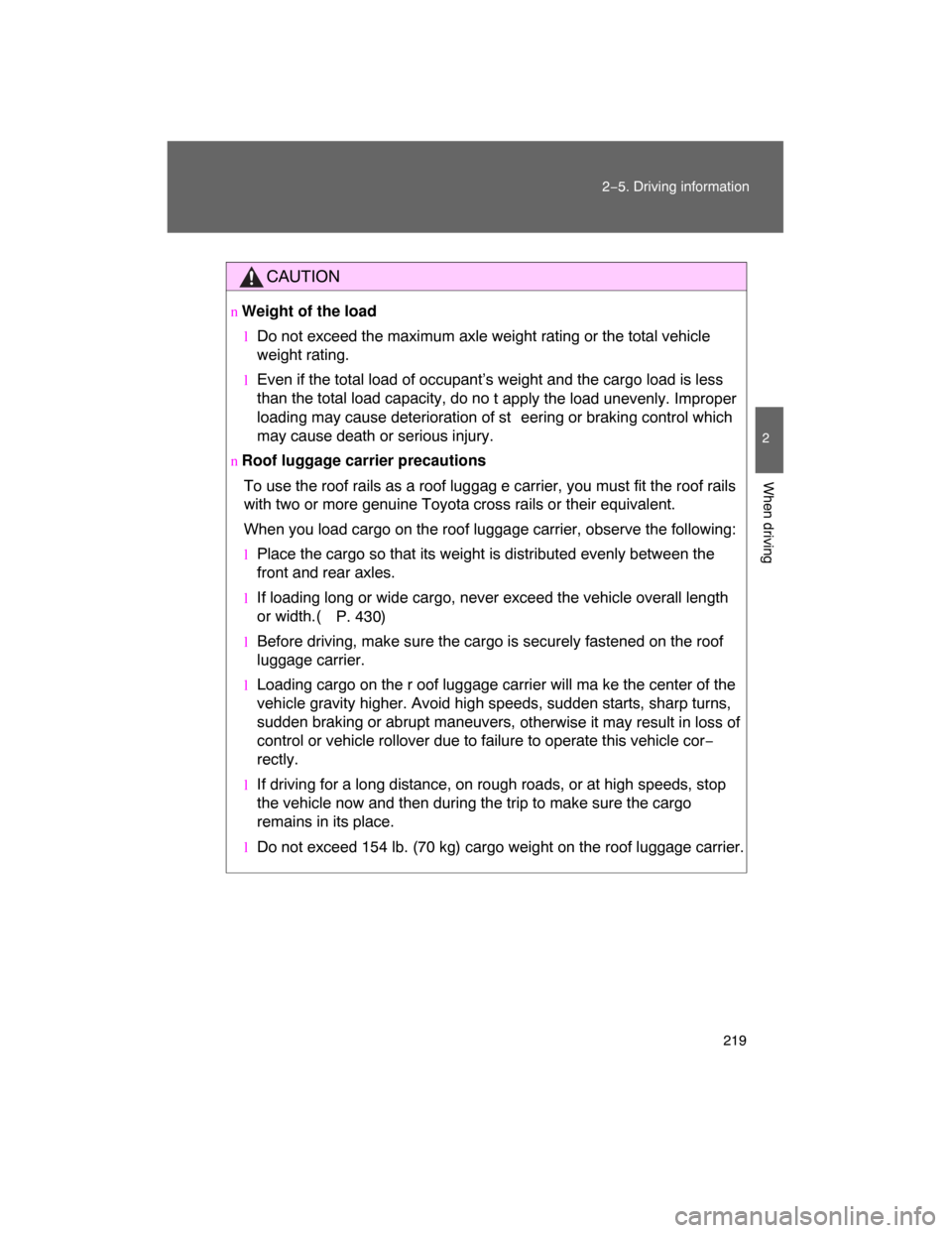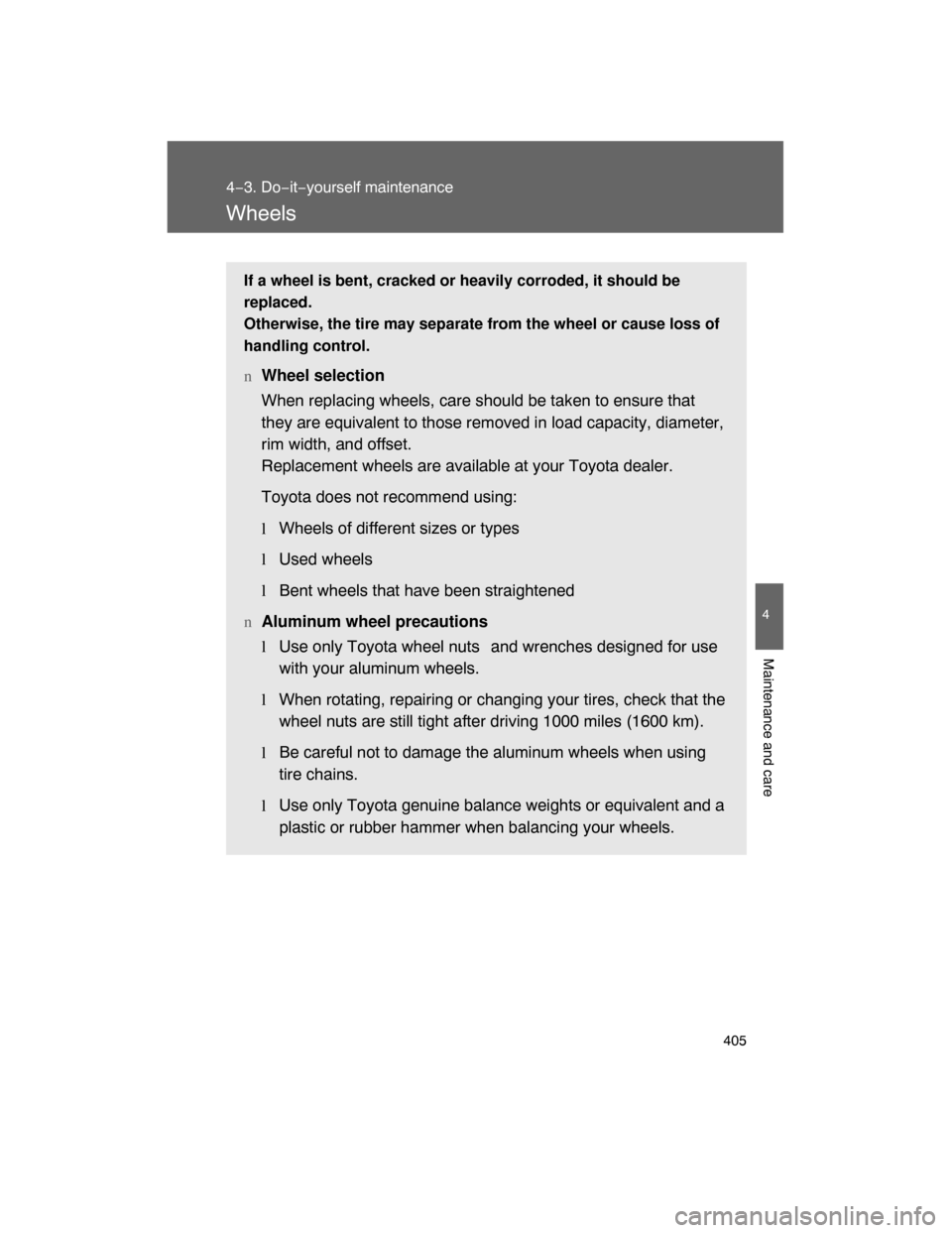Page 217 of 531

219
2−5. Driving information
2
When driving
CAUTION
n Weight of the load
lDo not exceed the maximum axle weight rating or the total vehicle
weight rating.
lEven if the total load of occupant’s weight and the cargo load is less
than the total load capacity, do no
t apply the load unevenly. Improper
loading may cause deterioration of st eering or braking control which
may cause death or serious injury.
n Roof luggage carrier precautions
To use the roof rails as a roof luggag e carrier, you must fit the roof rails
with two or more genuine Toyota cross rails or their equivalent.
When you load cargo on the roof luggage carrier, observe the following:
lPlace the cargo so that its weight is distributed evenly between the
front and rear axles.
lIf loading long or wide cargo, never exceed the vehicle overall length
or width.(
P. 430)
lBefore driving, make sure the cargo is securely fastened on the roof
luggage carrier.
lLoading cargo on the r oof luggage carrier will ma ke the center of the
vehicle gravity higher. Avoid high speeds, sudden starts, sharp turns,
sudden braking or abrupt maneuvers,
otherwise it may result in loss of
control or vehicle rollover due to failure to operate this vehicle cor−
rectly.
lIf driving for a long distance, on rough roads, or at high speeds, stop
the vehicle now and then during the trip to make sure the cargo
remains in its place.
lDo not exceed 154 lb. (70 kg) cargo weight on the roof luggage carrier.
Page 400 of 531

405
4−3. Do−it−yourself maintenance
4
Maintenance and care
Wheels
If a wheel is bent, cracked or heavily corroded, it should be
replaced.
Otherwise, the tire may separate from the wheel or cause loss of
handling control.
nWheel selection
When replacing wheels, care should be taken to ensure that
they are equivalent to those removed in load capacity, diameter,
rim width, and offset.
Replacement wheels are available at your Toyota dealer.
Toyota does not recommend using:
lWheels of different sizes or types
lUsed wheels
l
Bent wheels that have been straightened
n
Aluminum wheel precautions
l
Use only Toyota wheel nuts and wrenches designed for use
with your aluminum wheels.
l
When rotating, repairing or changing your tires, check that the
wheel nuts are still tight after driving 1000 miles (1600 km).
lBe careful not to damage the aluminum wheels when using
tire chains.
lUse only Toyota genuine balance weights or equivalent and a
plastic or rubber hammer when balancing your wheels.
Page 487 of 531
494
6−1. Specifications
Maintenance data (fuel, oil level, etc.)
Dimensions and weight
*: Unladen vehicle
Overall length194.9 in. (4950 mm)
Overall width
77.6 in. (1970 mm)
Overall height
*74.0 in. (1880 mm)
Wheelbase
112.2 in. (2850 mm)
TreadFront64.6 in. (1640 mm)
Rear
64.4 in. (1635 mm)
Vehicle capacity weight
(Occupants + luggage)
1235 lb. (560 kg)
Towing capacity
(trailer weight + cargo weight)
8500 lb. (3856 kg)
Page 502 of 531
509
6−1. Specifications
6
Vehicle specifications
Tire size
nTypical tire size information
The illustration indicates typical
tire size.
Ti r e u s e
(P = Passenger car,
T = Temporary use)
Section width (millimeters)
Aspect ratio
(tire height to section width)
Tire construction code
(R = Radial, D = Diagonal)
Wheel diameter (inches)
Load index (2 or 3 digits)
Speed symbol
(alphabet with one letter)
nTire dimensions
Section width
Tire height
Wheel diameter
P285/60R18 11 4V
ITY61C011
ITY61C012
Page 503 of 531
510 6−1. Specifications
Tire section names
Bead
Sidewall
Shoulder
Tread
Belt
Inner liner
Reinforcing rubber
Carcass
Rim lines
Bead wires
Chafer
Uniform Tire Quality Grading
This information has been prepared in accordance with regulations
issued by the National Highway Tr
affic Safety Administration of the
U.S.A. Department of Transportation.
It provides the purchasers and/or
prospective purchasers of Toyota
vehicles with information on uniform tire quality grading.
Your Toyota dealer will help answ er any questions you may have as
you read this information.
nDOT quality grades
All passenger vehicle tires mu
st conform to Federal Safety
Requirements in addition to these grades. Quality grades can be
found where applicable on the tire sidewall between tread shoulder
and maximum section width.
For example: Treadwear 200 Traction AA Temperature A
ITY61C013
Page 506 of 531

513
6−1. Specifications
6
Vehicle specifications
Tire related term Meaning
Normal occupant
weight150 lb. (68 kg) times the number of occupants
specified in the second column of Table 1
* that
follows
Occupant distributionDistribution of occupants in a vehicle as speci−
fied in the third column of Table 1
* below
Production options
weightThe combined weight of installed regular pro−
duction options weighing over 5 lb. (2.3 kg) in
excess of the standard items which they
replace, not previously considered in curb
weight or accessory weight, including heavy
duty brakes, ride levelers, roof rack, heavy duty
battery, and special trim
RimA metal support for a tire or a tire and tube
assembly upon which the tire beads are seated
Rim diameter
(Wheel diameter)Nominal diameter of the bead seat
Rim size designation Rim diameter and width
Rim type designationThe industry manufacturer ’s designation for a
rim by style or code
Rim width Nominal distance between rim flanges
Vehicle capacity
weight (Total load
capacity)The rated cargo and luggage load plus 150 lb.
(68 kg) times the vehicle’s designated seating
capacity
Vehicle maximum load
on the tire
The load on an individual tire that is determined
by distributing to each axle its share of the
maximum loaded vehicle weight, and dividing
by two
Page 509 of 531

516 6−1. Specifications
Tire related term Meaning
Overall widthThe linear distance between the exteriors of
the sidewalls of an inflated tire, including eleva−
tions due to labeling, decorations, or protective
bands or ribs
Passenger car tireA tire intended for use on passenger cars, mul−
tipurpose passenger vehicles, and trucks, that
have a gross vehicle weight rating (GVWR) of
10,000 lb. or less
Ply A layer of rubber−coated parallel cords
Ply separationA parting of rubber compound between adja−
cent plies
Pneumatic tireA mechanical device made of rubber, chemi−
cals, fabric and steel or other materials, that,
when mounted on an automotive wheel, pro−
vides the traction and contains the gas or fluid
that sustains the load
Radial ply tireA pneumatic tire in which the ply cords that
extend to the beads are laid at substantially 90
degrees to the centerline of the tread
Reinforced tireA tire designed to operate at higher loads and
at higher inflation pressures than the corre−
sponding standard tire
Section widthThe linear distance between the exteriors of
the sidewalls of an inflated tire, excluding ele−
vations due to labeling, decoration, or protec−
tive bands
SidewallThat portion of a tire between the tread and
bead
Sidewall separation
The parting of the rubber compound from the
cord material in the sidewall